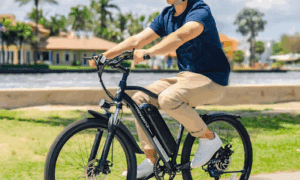The way we move around cities is changing fast. With increasing traffic congestion, rising fuel costs, and growing environmental concerns, urban dwellers are searching for smarter, cleaner, and more efficient transportation options. Enter electric scooters—a game-changer in urban mobility. These compact, eco-friendly vehicles are quickly becoming a favorite for short-distance commutes. But are they truly the future of city transportation? Let’s explore why electric scooters are gaining popularity and how they could reshape urban travel.
Why Electric Scooters Are Gaining Popularity
Electric scooters have surged in popularity over the past few years, and for good reason. First, they offer a convenient and affordable alternative to traditional transport. Unlike cars, which require fuel, insurance, and parking fees, e-scooters are cost-effective and easy to use. Many cities now have dockless scooter-sharing programs, allowing riders to pick up and drop off scooters at their convenience.
Additionally, electric scooters are environmentally friendly. With zero emissions, they help reduce air pollution—a major concern in densely populated urban areas. As cities push for greener transportation solutions, e-scooters fit perfectly into the vision of a sustainable future.
Another key factor is ease of use. Most electric scooters are lightweight, foldable, and portable. This makes them ideal for last-mile connectivity—bridging the gap between public transport and final destinations. Whether you’re commuting to work, running errands, or exploring the city, e-scooters provide a fast and flexible way to get around.
The Benefits of Electric Scooters for Urban Commuters
Cost-Effective Transportation
Owning a car or even relying on ride-sharing services can be expensive. Between fuel, maintenance, and parking, costs add up quickly. In contrast, electric scooters are much cheaper to operate. Charging an e-scooter costs just a few cents per ride, and maintenance is minimal. Many people find that investing in a personal e-scooter pays off within months compared to other transport options.
Reduced Traffic Congestion
Cities worldwide are struggling with traffic gridlock. Electric scooters take up far less space than cars, helping to ease congestion. When more people choose scooters over cars for short trips, roads become less crowded. This leads to smoother traffic flow and shorter commute times for everyone.
Eco-Friendly Commuting
Climate change is a pressing issue, and reducing carbon footprints is crucial. Unlike gas-powered vehicles, e-scooters produce no harmful emissions. By switching to electric scooters, cities can significantly lower their pollution levels. Some studies suggest that widespread e-scooter adoption could cut urban CO₂ emissions by millions of tons annually.
Health and Convenience
While e-scooters are motorized, they still encourage outdoor activity. Standing and balancing on a scooter engages core muscles, promoting better posture and slight physical activity. Moreover, they eliminate the stress of finding parking, making them a hassle-free option for quick trips.
Challenges Facing Electric Scooter Adoption
Despite their advantages, electric scooters face several hurdles before they can dominate urban mobility.
Safety Concerns
One major issue is safety. Many cities lack proper infrastructure for e-scooters, forcing riders to share roads with cars or pedestrians. This increases the risk of accidents. Some riders also ignore traffic rules, leading to injuries. To address this, cities must invest in dedicated bike lanes and enforce stricter e-scooter regulations.
Limited Battery Range
Most e-scooters have a range of 15-30 miles per charge, which is fine for short trips but not for longer commutes. While battery technology is improving, extended-range models are still expensive. Until battery life improves, e-scooters will remain a secondary transport option for many.
Theft and Vandalism
Since e-scooters are lightweight and portable, they are easy targets for theft. Scooter-sharing companies lose millions yearly due to stolen or damaged units. Better anti-theft technology, such as GPS tracking and robust locking mechanisms, could help mitigate this problem.
Regulatory Hurdles
Different cities have varying laws regarding e-scooters. Some allow them on bike lanes, others ban them from sidewalks, and a few prohibit them entirely. Clear, consistent regulations are needed to ensure safe and legal e-scooter use.
The Prospect of Electric Scooters in Urban Mobility
Despite challenges, the future of electric scooters looks promising. Here’s how they could evolve:
Improved Battery Technology
Advances in lithium-ion and solid-state batteries will extend e-scooter ranges while reducing charging times. Some companies are already testing swappable battery systems, allowing riders to exchange depleted batteries for fully charged ones in seconds.
Smart City Integration
As cities become smarter, e-scooters will integrate with IoT (Internet of Things) networks. This means real-time tracking, optimized parking zones, and AI-powered traffic management to prevent accidents.
Expansion of Scooter-Sharing Programs
Scooter-sharing services like Lime, Bird, and Spin are expanding globally. As more cities adopt these programs, e-scooters will become even more accessible.
Conclusion
Electric scooters are more than just a trend—they represent a shift toward smarter, cleaner urban mobility. While challenges remain, technological advancements and better city planning will likely overcome them. As more people embrace e-scooters, we could see fewer cars on the road, reduced emissions, and more efficient commutes.
For city dwellers looking for an affordable, eco-friendly, and convenient way to get around, electric scooters are an excellent choice. The future of urban transport is electric, and e-scooters are leading the charge.



































